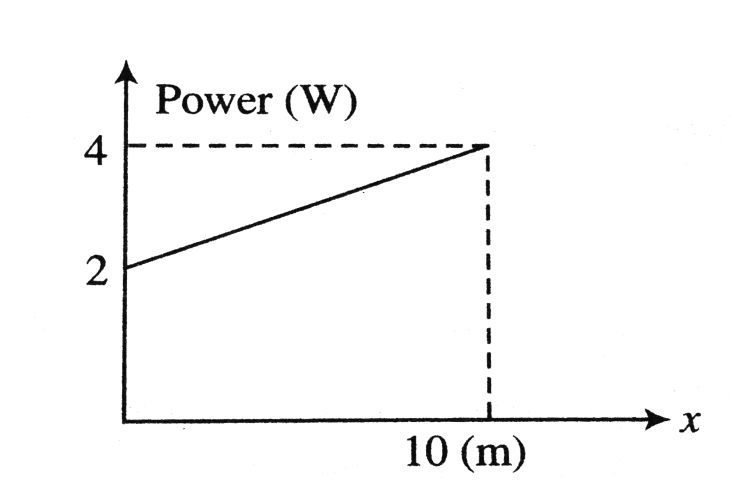
A particle A of mass $\dfrac{{10}}{7}kg$ is moving in the positive direction of $x$ . At initial position $x = 0$ its velocity is $1m/s$ , then its velocity at $x = 10m$ is: (use the graph given)

A) $4m/s$
B) $2m/s$
C) $3\sqrt 2 m/s$
D) $\dfrac{{100}}{3}m/s$
Answer
218.4k+ views
Hint: First, we will derive the relation between force and distance by using the relation between Power force and Velocity and the equate the area under the graph with the derived formula to get the final answer.
Formula used:
Power, $P = F \times v$
Where, $F$ is the force and $v$ is the velocity
Area of trapezium, $A = \dfrac{1}{2}(a + b) \times h$
Where, $a,b$ are the lengths of the parallel sides of trapezium and $h$ is the height of the trapezium.
Complete step by step solution:
As we know, Power, $P = F \times v$
Where, $F$ is the force and $v$ is the velocity
Also, $F = ma$ $ \Rightarrow P = ma \times v$
Since $a$ is the derivative of $v$ , and $v$ is the derivative of $m$ ,
$P = m\dfrac{{dv}}{{dt}} \times v \Rightarrow P = m\dfrac{{dv}}{{dx}}\dfrac{{dx}}{{dt}} \times v$
$ \Rightarrow P.dx = mvdv\dfrac{{dx}}{{dt}}$
Which gives, $P.dx = m{v^2}dv$ (since $\dfrac{{dx}}{{dt}} = v$ )
Integrating both sides,
$\int {P.dx = \int\limits_1^v {m{v^2}dv} } $
$ \Rightarrow P = [\dfrac{{m{v^3}}}{3}]_1^v$
Which gives, $P = \dfrac{m}{3}({v^3} - 1)$
Now we have mass equal to $\dfrac{{10}}{7}kg$
Also, the area under a curve between two points can be found by doing a definite integral between the two points. Here that area is present in the shape of trapezium. A trapezium is a $2D$ shape and a type of quadrilateral, which has only two parallel sides and the other two sides are non-parallel.
Therefore, Area of trapezium, $A = \dfrac{1}{2}(a + b) \times h$
Where, $a,b$ are the lengths of the parallel sides of trapezium and $h$ is the height of the trapezium.
$ \Rightarrow A = \dfrac{1}{2}(2 + 4) \times 10 = \dfrac{1}{2} \times 6 \times 10 = 30$
We derived a relation between power and distance. Equate both the values
$ \Rightarrow \dfrac{m}{3}({v^3} - 1) = 30$
$ \Rightarrow \dfrac{{10}}{{7 \times 3}}({v^3} - 1) = 30$
This gives, $v = 4m/s$
Hence, Option (A) is correct.
Note: Convert all the given values into SI units before using them in any question. Don’t forget to put units in the final answer. We had to derive a relation between Power and Mass because in the question, the graph is given in terms of Power and mass only.
Formula used:
Power, $P = F \times v$
Where, $F$ is the force and $v$ is the velocity
Area of trapezium, $A = \dfrac{1}{2}(a + b) \times h$
Where, $a,b$ are the lengths of the parallel sides of trapezium and $h$ is the height of the trapezium.
Complete step by step solution:
As we know, Power, $P = F \times v$
Where, $F$ is the force and $v$ is the velocity
Also, $F = ma$ $ \Rightarrow P = ma \times v$
Since $a$ is the derivative of $v$ , and $v$ is the derivative of $m$ ,
$P = m\dfrac{{dv}}{{dt}} \times v \Rightarrow P = m\dfrac{{dv}}{{dx}}\dfrac{{dx}}{{dt}} \times v$
$ \Rightarrow P.dx = mvdv\dfrac{{dx}}{{dt}}$
Which gives, $P.dx = m{v^2}dv$ (since $\dfrac{{dx}}{{dt}} = v$ )
Integrating both sides,
$\int {P.dx = \int\limits_1^v {m{v^2}dv} } $
$ \Rightarrow P = [\dfrac{{m{v^3}}}{3}]_1^v$
Which gives, $P = \dfrac{m}{3}({v^3} - 1)$
Now we have mass equal to $\dfrac{{10}}{7}kg$
Also, the area under a curve between two points can be found by doing a definite integral between the two points. Here that area is present in the shape of trapezium. A trapezium is a $2D$ shape and a type of quadrilateral, which has only two parallel sides and the other two sides are non-parallel.
Therefore, Area of trapezium, $A = \dfrac{1}{2}(a + b) \times h$
Where, $a,b$ are the lengths of the parallel sides of trapezium and $h$ is the height of the trapezium.
$ \Rightarrow A = \dfrac{1}{2}(2 + 4) \times 10 = \dfrac{1}{2} \times 6 \times 10 = 30$
We derived a relation between power and distance. Equate both the values
$ \Rightarrow \dfrac{m}{3}({v^3} - 1) = 30$
$ \Rightarrow \dfrac{{10}}{{7 \times 3}}({v^3} - 1) = 30$
This gives, $v = 4m/s$
Hence, Option (A) is correct.
Note: Convert all the given values into SI units before using them in any question. Don’t forget to put units in the final answer. We had to derive a relation between Power and Mass because in the question, the graph is given in terms of Power and mass only.
Recently Updated Pages
Chemical Properties of Hydrogen - Important Concepts for JEE Exam Preparation

JEE General Topics in Chemistry Important Concepts and Tips

JEE Atomic Structure and Chemical Bonding important Concepts and Tips

JEE Amino Acids and Peptides Important Concepts and Tips for Exam Preparation

JEE Extractive Metallurgy Important Concepts and Tips for Exam Preparation

Algebra Made Easy: Step-by-Step Guide for Students

Trending doubts
JEE Main 2026: Application Form Open, Exam Dates, Syllabus, Eligibility & Question Papers

Derivation of Equation of Trajectory Explained for Students

Hybridisation in Chemistry – Concept, Types & Applications

Understanding the Angle of Deviation in a Prism

Understanding Collisions: Types and Examples for Students

Understanding Atomic Structure for Beginners

Other Pages
JEE Advanced Marks vs Ranks 2025: Understanding Category-wise Qualifying Marks and Previous Year Cut-offs

Units And Measurements Class 11 Physics Chapter 1 CBSE Notes - 2025-26

NCERT Solutions For Class 11 Physics Chapter 8 Mechanical Properties Of Solids

Motion in a Straight Line Class 11 Physics Chapter 2 CBSE Notes - 2025-26

NCERT Solutions for Class 11 Physics Chapter 7 Gravitation 2025-26

How to Convert a Galvanometer into an Ammeter or Voltmeter




